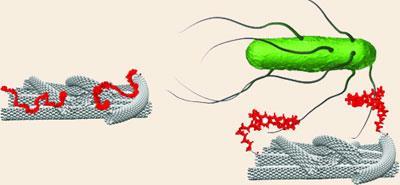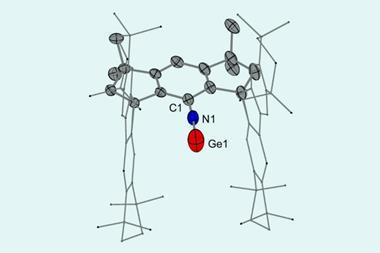Clever nanotubes promise to make spotting bacterial infections as easy as testing for pH
Sticky nanotubes that trap bacteria like flypaper can be used to identify bacterial infections in seconds rather than days, report Spanish chemists. Although only tested on the typhus-causing Salmonella typhi bacteria so far, if the process can be applied more widely it could revolutionise bacterial testing in the medical and food industries.
Detecting bacteria is currently a laborious process, requiring several stages that can take up to two days. Instead, this new method promises to be as easy as testing for pH, say researchers at the Universityof Rovira i Virgili in Catalonia, Spain.
The technique uses carbon nanotubes coated with aptamers - short strands of genetic material that bind tightly to specific bacteria. Electrodes are coated with these sticky nanotubes and then dipped into a test liquid. Rather like flypaper, bacteria stick to the aptamers, which partially peel away from the nanotubes, changing their electrical conductivity. By measuring this change, the number of bacteria in the solution can be calculated.

Importantly, the technique is very precise - able to detect concentrations as low as a single bacterium in 5 millilitres of solution. In future, the researchers hope that the process will be used to monitor bacterial infections in real-time, dramatically improving patient care in hospitals and guarding against batches of contaminated food.
’We are now working to apply the process to E. coli bacteria,’ says Jordi Riu, who worked on the project. ’The only thing holding us back is the availability of suitable aptamers for other bacteria.’
Many researchers across the world are hunting for new aptamers, Riu notes, but discovering them is not always easy, so it may be some time before a library is available for comprehensive testing. In the meantime, Riu’s team are working on miniaturising the technique to have it ready for practical applications.
’One of the benefits of this process is that the equipment is cheap and uncomplicated. We are confident it can be made into a hand-held system,’ Riu told Chemistry World, suggesting that disposable testing strips could be possible in the future.
’These results are of high scientific and practical interest,’ says Timothy Fisher, who works on nanotube-based biosensors at Purdue University in Indiana, US. ’The reported performance in terms of sensitivity, selectivity, and response linearity is excellent - so this technique should definitely be explored further.’
Fisher also acknowledges that using nanotubes is unlikely to make the process too expensive for widespread use. ’Notably, nanotube production does not require exotic raw materials so prices will continue to fall in the coming few years - making many applications feasible.’
Lewis Brindley
References
G A Zelada-Guillén et al, Angew. Chem. Int. Ed., 2009, DOI: 10.1002/anie.200902090






No comments yet